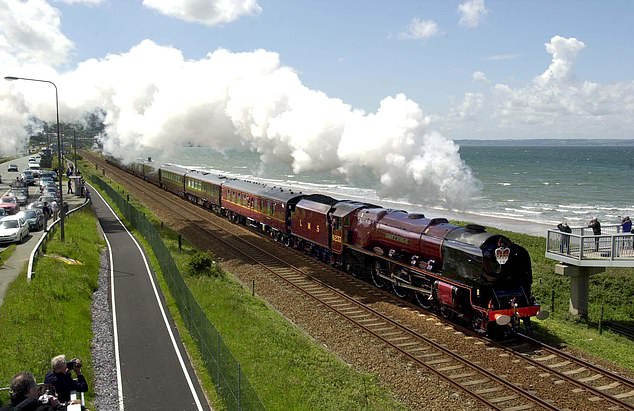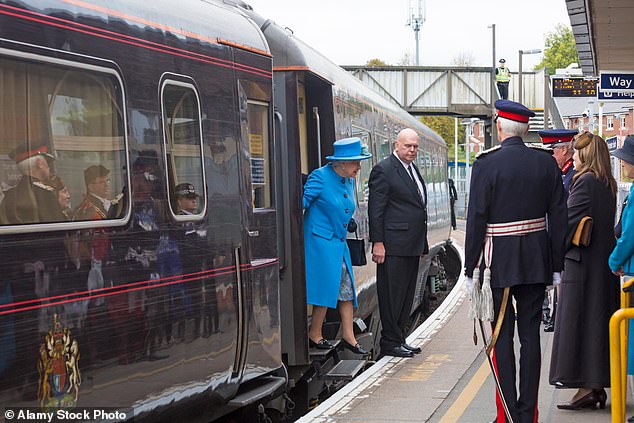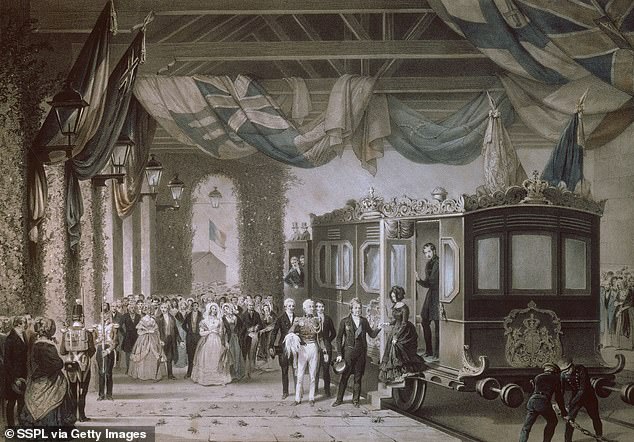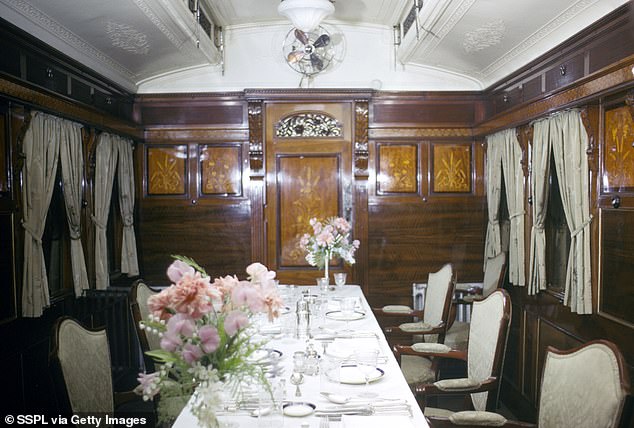Of all those places which can boast ‘Queen Elizabeth Slept Here’, there is only one with plastic taps, Formica tables, strip lighting – and an address in Milton Keynes.
Yet while it remains strictly off-limits for now, this most rudimentary of royal residences is going to be opened up to the rest of us in a couple of years.
Yesterday’s news from Buckingham Palace that the Royal Train is finally reaching the end of the line will certainly stir mixed feelings among trainspotters.
No longer will stations large and small enjoy the thrill of a visit from a spotless, claret-coloured train which would never be more than 15 seconds late or halt more than six inches either side of any red carpet.
On the other hand, the plan is for public access after the train ceases operations in 2027. So rail buffs can look forward to stepping inside a train like no other.
For while it may have the ambiance of a two-star hotel circa 1980 (I have only been aboard once and have an abiding memory of avocado bathroom suites and laminated wood panelling), it is also unmistakably grand, with its own ‘RT’ cypher and headed stationery.
There are armchairs, desks, full-length baths and, of course, wooden loo seats (look very closely, and you might even spot the bullet hole in the Royal Household dining car left when a royal policeman accidentally discharged his firearm in 2000).
Many will feel a twinge of both pride and sadness that the nation which actually invented the train – this year marks the 200th anniversary of the modern railway – has now decided to scrap what is, effectively, our national train.

The spotless, claret-coloured train steams through Penmaenmawr, north Wales during the Queen’s Golden Jubilee Tour in 2002

Queen Elizabeth alights the Royal Train in Dorchester in 2016
It seems inconceivable that if, say, the French or the Americans or the Chinese had invented locomotion, they would be scrapping their grandest example.
However, these days, the Royal Train seldom leaves its shed, just outside Milton Keynes. So, when the current servicing contract for the train expires in March 2027, it will not be renewed. This is partly because of the hefty cost of an upgrade and partly because the Royal Family have acquired two new helicopters.
In fact, people have been predicting its demise for decades, all the more since its grander sibling, the dear old Royal Yacht, was pensioned off in 1997. It was an open secret that the train was being kept in service as a dignified way of moving Elizabeth II around the country in her later years.
The late Queen would often step aboard last thing at night, knowing she would arrive wherever she needed to be the next morning, regardless of weather or traffic, with all the entourage on board, too. Both she and the Duke of Edinburgh were very fond of it.
I was lucky enough to have a guided tour just before the late monarch embarked on her Golden Jubilee tour of Britain in 2002. I remember that the Duke even had a framed, blown-up copy of his Senior Citizen’s Railcard alongside the wildlife prints on the wall of his carriage – except the royal coaches were not called carriages but ‘saloons’.
The saloons of the Queen and the Duke remained in operation until her death, leaving another seven carriages and two support (staff) vehicles still in service.

A depiction of Queen Victoria and Prince Albert arriving at Gosport Station. She would make frequent stops to eat and relieve herself, believing doing so on board was bad for the digestion

Edward VII’s dining room. He ordered new rolling stock resembling the Royal Yacht
You know if you are in a royal ‘saloon’ as the beds run length-ways, in line with the track (for comfort). Staff beds and bunks lie across the train, just as they do in a regular sleeper.
Modern royalty have certainly been a lot less demanding than earlier travellers. Queen Victoria believed it was bad for the digestive system either to eat or use the loo on board a train, so elaborate premises for ‘retiring’ would be built at stations along the route between London and Scotland.
Edward VII ordered new rolling stock with the proviso that it should be ‘as much like the Royal Yacht as possible’. George V used it for touring the country during the First World War (though Queen Mary had a strict rule that it should go no faster than 5 mph if she was in the bath).
During the Second World War, when Buckingham Palace was bombed nine times, it played a key role in moving the King and Queen safely around the country when they inspected troops and factories. The current rolling stock dates to 1986.
As we saw after the retirement of both Concorde and Britainnia, there will be no shortage of heritage groups desperate to maintain this historic chapter in our transport history for future generations.
For now, though, there are still more royal journeys to be completed – and one mystery, too. Later this year, bestselling crime writer Peter James brings out a new novel. It’s a whodunnit about a grand murder attempt – on board the Royal Train.












